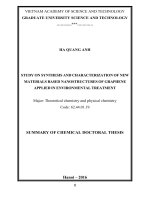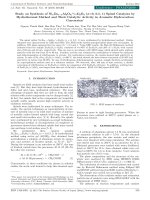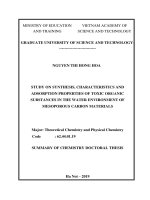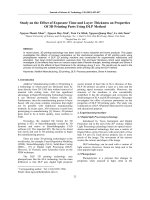Study on synthesis of biodegradable polyurea grease using modified vegetable oil
Bạn đang xem bản rút gọn của tài liệu. Xem và tải ngay bản đầy đủ của tài liệu tại đây (443.86 KB, 6 trang )
������������������������������������������������������������������������������������������������������������������������������������������������������������������������������������������������������������������������������������������������������������������������������������������������������������������������������������������������������������������������������������������������������������������������������������������������������������������������������������������������������������������������������������������������������������������������������������������������������������������������������������������������������������������������������������������������������������������������������������������������������������������������������������������������������������������������������������������������������������������������������������������������������������������������������������������������������������������������������������������������������������������������������������������������������������������������������������������������������������������������������������������������������������������������������������������������������������������������������������������������������������������������������������������������������������������������������������������������������������������������������������������������������������������������������������������������������������������������������������������������������������������������������������������������������������������������������������������������������������������������������������������������������������������������������������������������������������������������������������������������������������������������������������������������������������������������������������������������������������������������������������������������������������������������������������������������������������������������������������������������������������������������������������������������������������������������������������������������������������������������������������������������������������������������������������������������������������������������������������������������������������������������������������������������������������������������������������������������������������������������������������������������������������������������������������������������������������������������������������������������������������������������������������������������������������������������������������������������������������������������������������������������������������������������������������������������������������������������������������������������������������������������������������������������������������������������������������������������������������������������������������������������������������������������������������������������������������������������������������������������������������������������������������������������������������������������������������������������������������������������������������������������������������������������������������������������������������������������������������������������������������������������������������������������������������������������������������������������������������������������������������������������������������������������������������������������������������������������������������������������������������������������������������������������������������������������������������������������������������������������������������������������������������������������������������������������������������������������������������������������������������������������������������������������������������������������������������������������������������������������������������������������������������������������������������������������������������������������������������������������������������������������������������������������������������������������������������������������������������������������������������������������������������������������������������������������������������������������������������������������������������������������������������������������������������������������������������������������������������������������������������������������������������������������������������������������������������������������������������������������������������������������������������������������������������������������������������������������������������������������������������������������������������������������������������������������������������������������������������������������������������������������������������������������������������������������������������������������������������������������������������������������������������������������������������������������������������������������������������������������������������������������������������������������������������������������������������������������������������������������������������������������������������������������������������������������������������������������������������������������������������������������������������������������������������������������������������������������������������������������������������������������������������������������������������������������������������������������������������������������������������������������������������������������������������������������������������������������������������������������������������������������������������������������������������������������������������������������������������������������������������������������������������������������������������������������������������������������������������������������������������������������������������������������������������������������������������������������������������������������������������������������������������������������������������������������������������������������������������������������������������������������������������������������������������������������������������������������������������������������������������������������������������������������������������������������������������������������������������������������������������������������������������������������������������������������������������������������������������������������������������������������������������������������������������������������������������������������������������������������������������������������������������������������������������������������������������������������������������������������������������������������������������������������������������������������������������������������������������������������������������������������������������������������������������������������������������������������������������������������������������������������������������������������������������������������������������������������������������������������������������������������������������������������������������������������������������������������������������������������������������������������������������������������������������������������������������������������������������������������������������������������������������������������������������������������������������������������������������������������������������������������������������������������������������������������������������������������������������������������������������������������������������������������������������������������������������������������������������������������������������������������������������������������������������������������������������������������������������������������������������������������������������������������������������������������������������������������������������������������������������������������������������������������������������������������������������������������������������������������������������������������������������������������������������������������������������������������������������������������������������������������������������������������������������������������������������������������������������������������������������������������������������������������������������������������������������������������������������������������������������������������������������������������������������������������������������������������������������������������������������������������������������������������������������������������������������������������������������������������������������������������������������������������������������������������������������������������������������������������������������������������������������������������������������������������������������������������������������������������������������������������������������������������������������������������������������������������������������������������������������������������������������������������������������������������������������������������������������������������������������������������������������������������������������������������������������������������������������������������������������������������������������������������������������������������������������������������������������������������������������������������������������������������������������������������������������������������������������������������������������������������������������������������������������������������������������������������������������������������������������������������������������������������������������������������������������������������������������������������������������������������������������������������������������������������������������������������������������������������������������������������������������������������������������������������������������������������������������������������������������������������������������������������������������������������������������������������������������������������������������������������������������������������������������������������������������������������������������������������������������������������������������������������������������������������������������������������������������������������������������������������������������������������������������������������������������������������������������������������������������������������������������������������������������������������������������������������������������������������������������������������������������������������������������������������������������������������������������������������������������������������������������������������������������������������������������������������������������������������������������������������������������������������������������������������������������������������������������������������������������������������������������������������������������������������������������������������������������������������������������������������������������������������������������������������������������������������������������������������������������������������������������������������������������������������������������������������������������������������������������������������������������������������������������������������������������������������������������������������������������������������������������������������������������������������������������������������������������������������������������������������������������������������������������������������������������������������������������������������������������������������������������������������������������������������������������������������������������������������������������������������������������������������������������������������������������������������������������������������������������������������������������������������������������������������������������������������������������������������������������������������������������������������������������������������������������������������������������������������������������������������������������������������������������������������������������������������������������������������������������������������������������������������������������������������������������������������������������������������������������������������������������������������������������������������������������������������������������������������������������������������������������������������rbons in the vegetable oil, the phenyl moiety of aniline is
not compatible. As a result, the aniline sample is cloudy and separates the oil after a while.
Sample from mixed amines has similar properties but due to different reaction rates of amines
with isocyanate groups (cyclohexylamine reacts faster than dodecylamine due to less bulkiness),
the control of the composition and structure of polyurea is very difficult, which causes the
resulting product to be cloudy.
The results showed that all samples had high dropping point values, above 260 °C. A
relationship between thickener-oil compatibility and grease properties was also revealed: turbid
(low compatibility) samples have lower dropping point values. For the other two samples,
dodecylamine-derived thickener with longer carbon chain has better oil holding capacity and
thus has the highest dropping temperature value.
The penetration value allows a relative assessment of the thickener's thickening ability. The
results showed that the aniline-based grease had the lowest penetration value, followed by
cyclohexylamine and dodecylamine, respectively.
From the four-ball machine experiment, it can be seen that the anti-wear property of polyurea
grease follows the same pattern as the dropping point value. Inhomogeneous samples have rather
low weight load while dodecylamine with the best compatibility provides highest wear resistance.
Considering no anti-wear additive was used, the value of 233 kg can still be improved.
4. CONCLUSIONS
The canola oil was successfully modified using TMP through two steps procedure. The FTIR
and NMR showed that the glycerol was almost completely replaced by TMP. The modified oil
has technical parameters comparable to commercial oil. Results showed that the grease made
from synthesized oil and dodecylamine-based polyurea thickener have better properties than
grease using different types of amines. At very high dropping point of 278 oC, the grease can
work at much higher temperature range than traditional lithium grease. The high penetration of
275 mm-1 indicated that the grease has good pumpability. Also, four-ball test showed that nonadditives sample having good anti-wear property at 233 kg wear load.
Acknowledgement: This research was funded by Academy of Military Science and Technology
according to Science and Technology Agreement 51/2020/HDKHCN. We thank the Academy for the
financial support, which this work would not have been possible without.
Tạp chí Nghiên cứu KH&CN quân sự, Số Đặc san Hội thảo Quốc gia FEE, 12 - 2022
283
Hóa học – Sinh học – Mơi trường
REFERENCES
[1]. Arnsek, A., Vizintin, L. “Lubricating properties of rapeseed based oils”. Journal Synthetic
Lubricant, Vol. 16, pp. 281–295, (2000).
[2]. Jumat, S., Nadia, S., Emad, Y. “Industrial development and applications of plant oils and their
biobased Oleochemicals”. Arabians Journal of Chemistry, Vol. 5, pp. 135-145, (2012).
[3]. Wilson, B., “Lubricants and functional fluids from renewable sources”, Industrial Lubrication and
Tribology, Vol. 50, pp. 6-15, (1998).
[4]. T.-S. Chang, R. Yunus, U. Rashid. “Palm Oil Derived Trimethylolpropane Triesters Synthetic
Lubricants and Usage in Industrial”. Journal of Oleo Science, Vol. 64, pp. 143-151, (2015).
[5]. Uosukainen, E., Linko, YY., Lämsä, M. “Transesterification of trimethylolpropane and rapeseed oil
methyl ester to environmentally acceptable lubricants”. J Amer Oil Chem Soc, Vol. 75, pp. 15571563, (1998).
[6]. Robiah Y., Ahmadun F., Tian L., Sunny E., Joseph M. “Lubrication properties of trimethylolpropane
esters based on palm oil and palm kernel oils”. Eur. J. Lipid Sci. Technol. Vol. 106, pp. 52-60, (2004).
[7]. Rokni, K., Mostafaei, M., Dehghani-Soufi, M. “Microwave-assisted synthesis of trimethylolpropane
triester (bio-lubricant) from camelina oil”. Scientific Report, Vol. 12, 11941, (2022).
[8]. Guanllin Ren, Pengfei Zhang, Xiangyuan Ye, Wen Li, Xiaoqiang Fan, Minhao Zhu. “Comparative
study on corrosion resistance and lubrication function of lithium complex grease and polyurea
grease”. Friction, Vol. 9, pp. 75-91, (2021).
[9]. L. Liu, H. W. Sun. “Impact of polyurea structure on grease properties”, Lubrication Science, Vol.
22, pp. 405-413, (2010).
[10]. Guanllin Ren, Xiaowen Sun, Wen Li, Hao Li, Lin Zhang, Xiaoqiang Fan, Dongshan Li, Minhao Zhu,
“Improving the lubrication and anti-corrosion performance of polyurea grease via ingredient
optimization”. Friction, Vol. 9, pp. 1077-1097, (2021).
TĨM TẮT
Nghiên cứu chế tạo mỡ bơi trơn polyurea phân hủy sinh học từ dầu thực vật biến tính
Các chất bôi trơn hiện tại đang được sử dụng phổ biến trong rất nhiều ngành công
nghiệp do khả năng làm giảm ma sát cũng như nhiệt sinh ra khi vận hành thiết bị, đồng
thời bảo vệ các chi tiết kim loại khỏi mơi trường có tính ăn mịn. Trong một số ứng dụng,
đặc biệt là trong hàng hải, các loại mỡ bơi trơn cần phải có khả năng phân hủy sinh học,
nếu khơng chúng sẽ tích tụ và gây hại cho môi trường nước. Để giải quyết vấn đề này, dầu
thực vật biến tính được sử dụng thay thế dầu khoáng trong thành phần chế tạo mỡ. Hơn
nữa, trong điều kiện bị ngâm dưới nước, mỡ poliurea hoạt động tốt hơn mỡ liti truyền
thống do mỡ liti dễ bị rửa trơi. Do đó, trong nghiên cứu này, chất làm đặc poliurea được
chế tạo trực tiếp trong dầu thực vật biến tính có khả năng phân hủy sinh học, sử dụng tiền
chất là methylene diphenyl diisocyanat và các amin. Tính chất hóa học của mỡ tạo thành
được xác định bằng FTIR, khả năng bôi trơn được đánh giá qua nhiệt độ nhỏ giọt, độ lún
kim và phương pháp bốn bi. Kết quả cho thấy mỡ poliurea có nhiệt độ làm việc cao, khả
năng bơm và khả năng chống mài mòn tốt.
Từ khố: Mỡ poliurea; Phân hủy sinh học; Chất bơi trơn; Dầu thực vật biến tính.
284 N. D. Anh, N. H. Van, T. V. Hien, “Study on synthesis of biodegradable … modified vegetable oil.”









